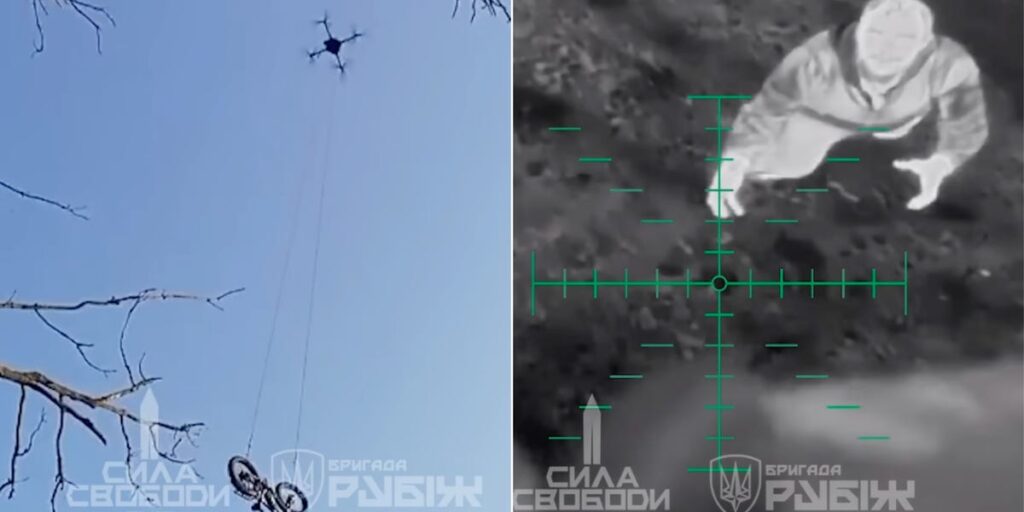A Ukrainian brigade said it used first-person-view drones to deliver e-bikes to a surrounded soldier, marking a rare instance where such devices were used to airlift a vehicle in battle.
In a video published on Wednesday, the “Rubizh” 4th Brigade of Ukraine’s National Guard said it dropped the roughly 88-pound e-bikes so the soldier could escape mostly Russian-controlled territory.
While the brigade didn’t say in the video when the operation occurred, it said the soldier had been trapped at a shelter near Siversk, a town in Donetsk, where fighting is still ongoing.
“The enemy was in front, behind, and on both flanks. Completely surrounded,” Mykola Hrytsenko, a junior lieutenant serving as the brigade’s chief of staff, said in the video.
The soldier, whom the brigade identified by the call sign Tankist, was the only survivor of four Ukrainian soldiers fighting in the area, Hrytsenko said.
“The Siversk direction is known for incredibly difficult logistics. Almost none exists there. Guys have to walk six to seven kilometers on foot to reach a position,” he said.
Hrytsenko said his team crafted an evacuation plan that involved heavy cargo drones, such as the Baba Yaga or Heavy Shot, carrying a bicycle with an electric motor to the exhausted soldier’s position.
Such drones are typically used in Ukraine as bombers and are designed to deliver payloads of about 40 to 50 pounds, though they can also airlift cargo.
Carrying a nearly 90-pound e-bike, Hrytsenko said, would push the drone to its limits and shorten its range to roughly 2 kilometers.
It took three attempts, brigade says
Hrytsenko said his team initially lost two drones trying to deliver e-bikes to the soldier. The first was shot down with the bike, while the second crashed because its motors burned out, he added.
But the “Rubizh” brigade published clips of the third drone carrying the bike via a winch system and the soldier appearing to receive the bike. Business Insider could not independently verify the authenticity of the brigade’s footage.
Hrytsenko said the bike’s parts were disassembled and brought to a nearby position on the frontline. Afterward, the vehicle was put together and flown to the soldier, he added.
“Everyone in HQ was shouting and crying like we’d just launched the first plane in the sky,” Hrytsenko said of the moment when the bike arrived.
The brigade also showed surveillance drone footage of a soldier riding an e-bike through the battlefield.
Hrytsenko said that while the soldier later struck a land mine, he was able to walk several hundred meters to a nearby friendly position, where drone pilots flew in another e-bike so he could fully exit the combat zone.
“The operation cost us two lost e-bikes, around $100,000, and two lost HeavyShot drones, $15,000 each,” Hrytsenko said.
The brigade said the soldier evacuated safely and showed interview clips of a man it said was Tankist. BI could not independently verify his identity.
Hrytsenko added that the e-bikes were funded via donations from volunteers, a common occurrence in Ukraine, where units have to crowdfund for drones and weapons.
“If you see a strange fundraiser for an e-bike, or a unicycle, don’t be surprised. Maybe it will save a life,” he said.
First-person-view, or FPV, drones have been used for many non-combat functions during the war, such as dropping small items on the battlefield or compelling soldiers to surrender via loudspeaker.
However, this marks one of the first times such a drone has been used to deliver a large asset like a vehicle during ongoing fighting. Given that the size of the payload may make a drone easier to spot while limiting its range, it’s unclear if this tactic will become more commonplace.
Read the full article here


